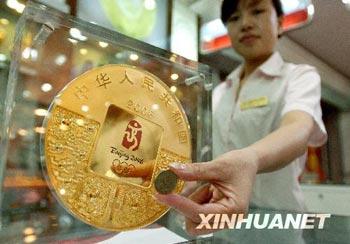Source: CCTV.com
11-07-2008 14:14
This is a small, inconspicuous booth in a Shanghai Coin market, easy to overlook. Who’d ever thought that one of its regular customers is none other than the legendary American investment master Jim Rogers. He drops by nearly every time he visits the city to buy China-made gold coins.
 |
| 2008 Olympic commemorative gold coin |
The booth is run by Xu Jianxin, a veteran gold vendor. He tells us Rogers bought the Panda Gold Coins, one of the earliest coins issued in China, during the 1980s, and has collected the whole set.
In fact, the production and collection of gold coins dates back to the Shang Dynasty, more than three thousand years ago in China. And the issuance of gold coins in modern times began in 1979, when China issued the first set of gold coins to commemorate the 30th anniversary of the founding of the People's Republic of China.
Since then, China has issued over 15 hundred kinds of gold coins. But it only began gaining popularity, in the late 1990s.
Jiang Huiqing, Industry Insider said "In the early times, because our economy was comparatively weak, the nation’s average income was low. Prior to 1997. most gold coins were issued overseas. However, after 1997, the national economy developed along with the reform and opening-up policy. People’s well-being and income grew. And people began to collect and invest, in gold coins."
That trend really took off, in the late 1990's. What use to be a one billion yuan industry in the early nineties, is now worth over 10 billion. Meanwhile, market prices for gold coins issued between 1998 to 2006 has risen by at least 30 percent to more than 10 times, depending on the coin. Such robust numbers has attracted more and more people to join the gold coin collection band-wagon.
But, it’s more than just about the money. Gold collection also holds a special place in Chinese people’s hearts, because of their high cultural and aesthetic value.
Jiang Huiqing said "The themes of gold coins issued in China since 1979 to now cover over five thousand years of Chinese culture. They also commemorate important, key figures in Chinese history, scientific milestones, and our overall cultural civilization."
So-gold collection became almost like a way to hold on, to a piece of history. That desire became even more evident, in the lead up to the Beijing Olympic Games. Various kinds of gold-made Olympic Souvenirs were warmly embraced and snapped up by the market. That not only boosted the gold market and gold consumption, but also raised the social awareness of gold collection.
